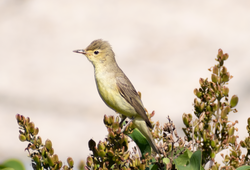| Icterine warbler | |
|---|---|
 | |
| In Czech Republic | |
| Scientific classification | |
| Kingdom: | Animalia |
| Phylum: | Chordata |
| Class: | Aves |
| Order: | Passeriformes |
| Family: | Acrocephalidae |
| Genus: | Hippolais |
| Species: | H. icterina |
| Binomial name | |
| Hippolais icterina (Vieillot, 1817) | |
 | |
| Range of Icterine Warbler Breeding Passage Non-breeding | |
The Icterine warbler (Hippolais icterina) is an Old World warbler in the tree warbler genus Hippolais . It breeds in mainland Europe except the southwest, where it is replaced by its western counterpart, the melodious warbler. It is migratory, wintering in sub-Saharan Africa.

